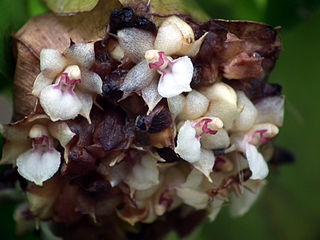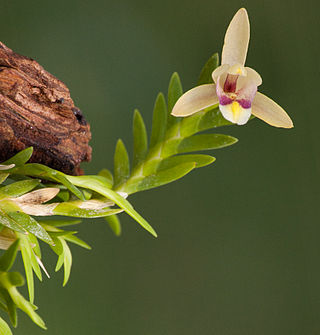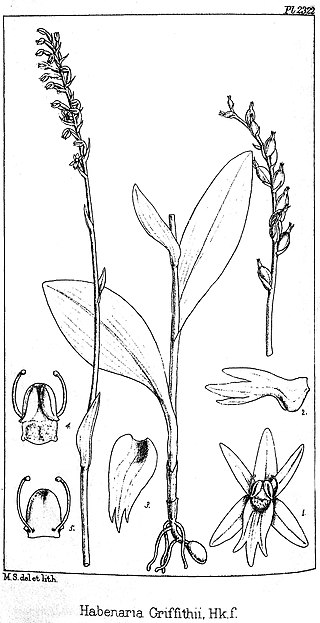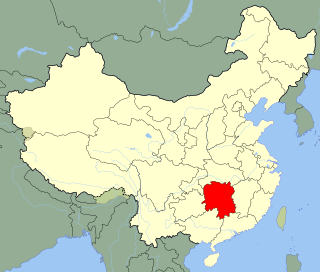
Agrostophyllum is a genus with about ninety species from the orchid family (Orchidaceae). The genus name is derived from the Greek words agrostis ("grass") and phyllos ("leaf"), referring to the grass-like appearance of the leaves of some species.

Schlumbergera is a small genus of cacti with six to nine species found in the coastal mountains of south-eastern Brazil. These plants grow on trees or rocks in habitats that are generally shady with high humidity, and can be quite different in appearance from their desert-dwelling cousins. Most species of Schlumbergera have stems which resemble leaf-like pads joined one to the other and flowers which appear from areoles at the joints and tips of the stems. Two species have cylindrical stems more similar to other cacti.

Caladenia, commonly known as spider orchids, is a genus of 350 species of plants in the orchid family, Orchidaceae. Spider orchids are terrestrial herbs with a single hairy leaf and a hairy stem. The labellum is fringed or toothed in most species and there are small projections called calli on the labellum. The flowers have adaptations to attract particular species of insects for pollination. The genus is divided into three groups on the basis of flower shape, broadly, spider orchids, zebra orchids and cowslip orchids, although other common names are often used. Although they occur in other countries, most are Australian and 136 species occur in Western Australia, making it the most species-rich orchid genus in that state.

Rhizanthella, commonly known as underground orchids, is a genus of flowering plants in the orchid family, Orchidaceae and is endemic to Australia. All are leafless, living underground in symbiosis with mycorrhizal fungi. The inflorescence is a head of flowers held at, or just above the ground but mostly covered by soil or leaf litter and little is known about the mechanism of pollination.

Prosthechea is a genus of flowering plants in the orchid family (Orchidaceae). The name is derived from the Greek word prostheke (appendix), referring to the appendage on the back of the column. Appendage orchid is a common name for this genus. Prosthechea is abbreviated Psh. in the horticultural trade.

Roystonea is a genus of eleven species of monoecious palms, native to the Neotropics, in the Caribbean, the adjacent coasts of Florida in the United States, Mexico, Central America and northern South America. Commonly known as the royal palms, the genus was named after Roy Stone, a U.S. Army engineer. It contains some of the most recognizable and commonly cultivated palms of tropical and subtropical regions.

Houlletia is a genus of large-growing epiphytic orchids native to Mexico, and possibly also Guatemala through Central America to Bolivia. was established with the publication by Brogniartt of Houlletia brocklehurstiana in 1841. The genus is named in honor of orchid collector and grower M. Houllet, French orchid collector in Brazil, later the director of the Botanic Jardin des Plantes in Paris, 19th century.

Dactylorhiza maculata, known as the heath spotted-orchid or moorland spotted orchid, is an herbaceous perennial plant of the family Orchidaceae. It is widespread in mountainous regions across much of Europe from Portugal and Iceland east to Russia. It is also found in Algeria, Morocco, and western Siberia.

Bromheadia, commonly known as reed orchids, is a genus of about 29 species of orchids in the family Orchidaceae. They are evergreen terrestrial and epiphytic plants with unbranched stems, the leaves arranged in two rows along the flowering stem. The flowers appear in succession near the end of the flowering stem with the sepals and petals free from each other. The labellum is like a landing platform and has three lobes. They are native to areas from tropical Asia to northern Australia.

Dendrobium nobile, commonly known as the noble dendrobium, is a member of the family Orchidaceae. It has become a popular cultivated decorative house plant, because it produces colourful blooms in winter and spring, at a time when little else is in flower. It is also one of the 50 fundamental herbs used in traditional Chinese medicine, known as shí hú or shí hú lán. Dendrobium nobile is one of the most widespread ornamental members of the orchid family. Its blooms are variegated in colour, shading from white through pink and purple, and the many different cultivated varieties produce different sized and coloured blooms.

Vanda christensoniana is a species of orchid endemic to Vietnam. The specific epithet christensoniana honours the botanist and taxonomist Eric Christenson.

Diploprora is a genus of flowering plants from the orchid family, Orchidaceae. It contains two recognized species, native to Asia:

Microsaccus is a genus of flowering plants from the orchid family, Orchidaceae. It is native to Southeast Asia.

Nepenthes robcantleyi, or Robert Cantley's pitcher plant, is a tropical pitcher plant endemic to the Philippine island of Mindanao. It is closely allied to N. truncata and was once considered a dark, highland form of this species. Nepenthes veitchii from Borneo is also thought to be a close relative.

Limodorum is a genus of myco-heterotrophic orchids. All species are temperate terrestrial plants and occur across much of Europe, North-West Africa, the Mediterranean Islands, and as far east as Iran. Plants have evolved away from photosynthesis and as a result their leaves are reduced to scales. There is still chlorophyll present but the plants are believed to be solely dependent on their fungal partner for nutrients. They spend most of their life underground as a short stem with fleshy roots, the unbranched inflorescence can appear in April to June if conditions are favourable.

Dyakia is a genus of orchids. It contains only one species, Dyakia hendersoniana(Rchb.f.) Onyx, endemic to the Island of Borneo.

Gennaria griffithii is a species of flowering plant in the family Orchidaceae, native from Afghanistan to China. It is a terrestrial species, with a small tuber and small greenish flowers, found in damp places. It has a complicated taxonomic history, having been transferred between genera several times. When placed in a genus on its own it is correctly known as Dithrix griffithii. In 2015, it was transferred to the genus Gennaria.

Phalaenopsis difformis, also known as the dark brown Phalaenopsis, is a species of epiphytic orchid native to Assam, Borneo, China South-Central, China Southeast, East Himalaya, Laos, Malaya, Myanmar, Bangladesh, Nepal, Sumatera, Thailand, Vietnam and West Himalaya.

Phalaenopsis hygrochila, also known as 湿唇兰 in Chinese, is a species of epiphytic orchid native to Assam, China South-Central, China Southeast, East Himalaya, Laos, Myanmar, Thailand, and Vietnam.

Phalaenopsis tsii is a species of orchid native to Southeast China. The specific epithet tsii honours Zhan-huo Tsi, who discovered Phalaenopsis subparishii. It has only been known from Mount Shunhuang in Hunan, China.





















